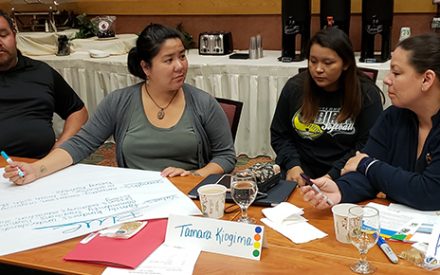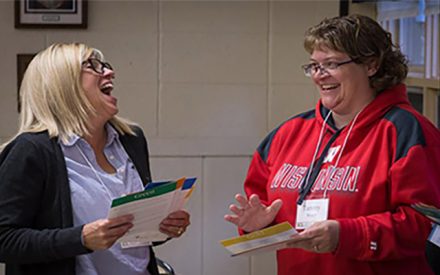Perhaps some people cringe when they hear the term “strategic planning” because they have experienced a tedious process that did not provide the outcomes they expected. But strategic planning can be a rewarding endeavor that is instrumental in launching an organization to the next level. Put plainly, strategic planning is about helping an organization determine and map out the steps needed to help them get from where they are now to where they want to be. Organizations engage in strategic planning to:
- increase effectiveness and efficiency
- improve understanding through better learning
- make better decisions
- enhance organizational capabilities
- improve communication and public relations
- increase political support
Extension educators collaborate with non-profit organizations, coalitions and local units of government to design and facilitate strategic planning processes throughout Wisconsin. For example, the Sauk County Historical Society (SCHS) asked Jen Erickson, Extension Community Development Educator, to facilitate a strategic planning process designed to provide direction for their work, but also to ensure that the organization has the capacity to achieve its goals. As part of the process, the SCHS:
- reviewed their mission statement
- updated the core values that drive the organization
- identified key stakeholders and developed criteria the stakeholders might use to gauge the performance
- analyzed the strengths, weaknesses, opportunities and challenges facing their organization
Ultimately, the SCHS built their plan around four strategic directions and developed strategies designed to guide the organization’s work priorities and strengthen the internal leadership capacity of the organization. Following approval of the strategic plan, the SCHS developed a new committee structure with annual plans of work and accountability measures. The feedback from the planning process has been overwhelmingly positive.
“In four sessions, Jen brought focus into the planning process, helped the board establish defined goals and objectives for the Society, and built board understanding of the value and purpose of prioritized committee work. She truly is a master at managing collaboration, communication, and creative innovation, highly valued skills that produce leadership results essential for the growth of any organization.” – SCHS Strategic Planning Participant
After approving the strategic plan, the SCHS reached out to Erickson to facilitate a process that would build consensus within their organization around the vision for three historically significant and sacred sites located in Sauk County. These sites include the only remaining man-shaped effigy mound in North America; the memorial site for Ho-Chunk leader, Chief Yellow Thunder and his wife; and Native American garden beds that were constructed over 1000 years ago. Erickson collaborated with Annie Jones, Extension Organization Development Specialist and Tribal Liaison to develop and facilitate a culturally relevant process that respected and reflected the sacred nature of the sites.
Erickson and Jones utilized the medicine wheel, an indigenous methodology, to co-facilitate SCHS planning in a virtual format due to Covid-19 pandemic concerns. The medicine wheel is a holistic inquiry approach that reflects on the spirit, heart, mind and body of agreed-upon planning issues. These components of the medicine wheel align with typical action planning frameworks that include purpose, assessment, tactics and implementation.
There are some key cultural lessons of the medicine wheel that are especially helpful for planning efforts. For instance, the components (spirit, heart, mind and body) are seen as interconnected and equally important gifts. All gifts must be utilized and addressed in order to achieve an intended change. This type of action planning and inquiry allowed the team to look through the lens of Sauk County area’s ancestors who have long passed.
- In the spirit, or purpose, discussion for the Man Mound effigy, the group asked themselves, “How is Man Mound calling our name?” and, “What is our higher purpose for this sacred site?”
- The heart, or assessment, conversation centered on, “What is getting in the way of achieving our higher purpose?” and, “What helps us achieve our purpose?”
- Mind, or tactics, focused on, “What are a few things that we could do that would help us really make a difference for this sacred site?”
- Body, or implementation, looked at the action steps that are needed to achieve the purpose and intentions of the team’s work.
Similar steps were taken for the Chief Yellow Thunder Memorial and the Hulburt Garden sacred sites, and as a result, SCHS created three distinct, yet interconnected, plans for each of the three sites.
“Working with Jones and Erickson regarding planning for the three sacred sites that SCHS owns was very engaging. Using the medicine wheel was not only culturally appropriate but also highly productive as it helped guide discussion, choices, and plans and brought a new way of thinking about these sites and the issues they face. The end result was consensus among the committee as it moves forward with plans for these important and sacred places.”- Paul Wolter, Executive Director, Sauk County Historical Society


 Extension to develop tribal-focused leadership program
Extension to develop tribal-focused leadership program Transform your team by understanding your Real Colors®
Transform your team by understanding your Real Colors® Goodbye icebreakers, hello improv!
Goodbye icebreakers, hello improv! Leading in times of change
Leading in times of change


